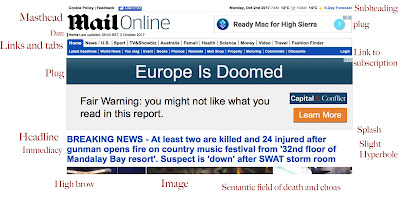An evolving media product
The Mail online contains various changes compared to The Daily Mail. The plugs are changeable and appeal to you as they are usually based around search history etc (for example in the picture above a Mac advertisement appealing to the laptop I used to research the page), similar to the guardian there are drop down tabs which allow you to refine what article you want rather than searching through a newspaper (acts like a index page), moving pictures and video links, weather updates and time to show when it was last updated (8:40am on the picture above), login opportunities and social media links further down the page. The masthead is still at the top, article headlines and the copy following, plugs advertising various things and the style of the newspaper is still the same. One noticeable difference however is that the headlines are slightly longer and include more information which could possibly be to draw the audience in.
The Guardian online differs from the print version in the fact that it includes the weather as a sub heading (which is constantly updated), the pictures in the main article change in a cycle, there are drop down tabs opening to a selective story type (e.g politics), the copy is more brief and has links to videos and there are links to subscription to the page. Similar characteristics include that the masthead is positioned still at the top, there are multiple articles on the page and various plug advertisements.
Codes and conventions
The Daily Mail online and The Guardian do appear to follow some of the codes and conventions of their print as shown above. Both papers evidentially have headlines, copy, splash however the layout creates a difference between the print version and online version. For example in the Guardian online the headline is much longer than the print version and the copy that follows it is shorter as there is a link directing the online reader to the full story. The masthead is still needed and used as it establishes the title of the newspaper. As opposed to multiple stories on the front page of the online version, both newspapers have links and tabs to different areas of the newspaper, directing the reader to the articles they desire. There are also extra digital elements which are not conventional of the print versions as the platform is not supportive in the print versions, which makes the elements unique to the online version. These extra digital elements included are used to add more detailed and accessible information, with things such as weather updates and the availability to publish breaking news quickly (as shown in the daily mail with the article regarding the Las Vegas shooting which occurred at 12:38am this morning already being shown on their website. This would not typically be in the print version as the papers would have been printed and sent out by that time so typically the print version could not cover it).
News values
I believe that the political ideologies are not made clear on the online version of the Guardian as the Guardian appeals to a more factual and quality genre. From visiting the politics page I believe that there are some left-wing ideologies shown with stories regarding Brexit etc. Some of the stories are quite negative, for example "Theresa May dodges question on Johnson's future" which conveys a negative judgement of May which furthermore backs up the left-wing ideology, especially through the verb 'dodges' as the headline is implying that May is naive. As a whole however the Guardian does not tend to show a strong view politically due to the values of the newspaper which portray professionalism and facts over bias and opinionated stories.
The Daily Mail online lacks a politics tab on their page and from the stories shown I believe that you can't really acknowledge what political party they lean towards as the prominent story regards a shooting in Las Vegas which is main news that isn't centralised towards a certain ideology due to its audience being bigger than usual with the urgency of the story. Further down the page we see the informality which is typical to the print Daily Mail with articles about celebrities etc. rather than politics.
Readership and audience
I believe that the audience for the Guardian differs slightly as it does not include a more left-wing view rather it equals out so therefore it may not attract the same audience. However that is only politically. I believe that the older generation would still enjoy the stories however as it is online
the older generation may struggle to access it as stereotypically they struggle to use online technology. Middle class people would still see the appeal I believe and perhaps enjoy it more as it is accessible and easy to use on a daily commute for example.
The audience for the Daily Mail would remain very similar I believe due to the up to date celebrity coverage which would appeal to the lower/middle class.
Investment in online publication
Personally I believe that the Mail online invests more profit in their online version due to the celebrity coverage that is broadcasted on social media (such as Facebook and Snapchat) which generates more views and interest yearly compared to political and sporting news from the Guardian which is only relevant to some audiences at one time (e.g Brexit).
Generating income
Income is money that an individual or business receives in exchange for providing a good or service or through investing capital. Profit however is a financial gain, especially the difference between the amount earned and the amount spent in buying, operating, or producing something. I believe that these two newspapers generate income by providing relevant services that the audience enjoy. Their profit is probably made through advertisements online or through reposts on social media (or equivalent dependant on platform).
Interactive elements
On the Daily Mail Online interactive elements include a weather update, links to social media, opportunity to 'like' the page on Facebook and easily accessible tabs to features of the newspaper which may increase reader loyalty as they have more opportunities to access the page, especially if they choose to 'like' it on Facebook at then they are linked to the page and are able to get constant updates.
The Guardian offers similar interactive elements to the Daily Mail to increase reader loyalty. One things it enforces more than the Daily Mail is the subscription option. This allows the reader to remain loyal to the Guardian as it allows constant updates to be sent to the particular subscriber which may be altered to suit them to draw them in more with tailored articles.




Comments
Post a Comment